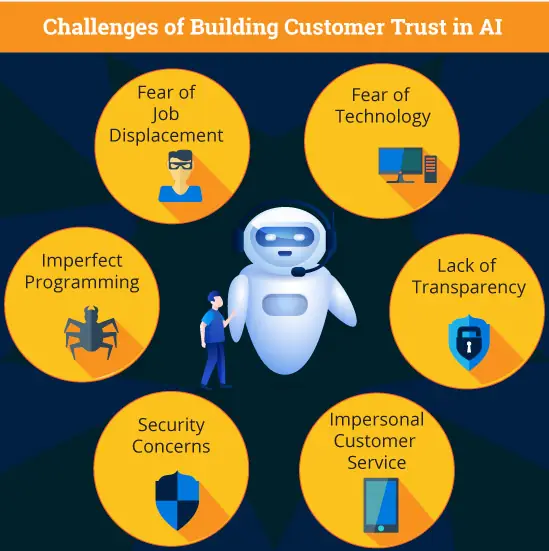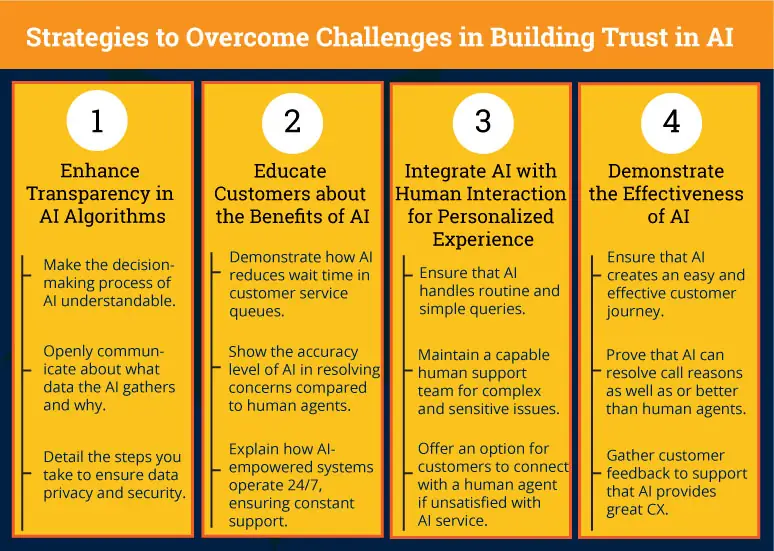The advancement of artificial intelligence (AI) technology in the call center industry has been monumental. However, despite its promising potential, gaining customer trust in AI is a considerable challenge that needs to be addressed.
Consider this scenario:
Customer: Hello, I need assistance with a billing issue on my account.
Voicebot: Good day! I'm here to help you with any billing concerns you may have. Please provide me with your account number and a brief description of the issue.
Customer: Alright, my account number is 123456789, and I was charged twice for my last subscription payment.
Voicebot: Thank you for providing that information. I'm sorry to hear about the double charge on your subscription. I'll look into that for you. It may take a moment to review your account.
Customer: Can I speak to a human representative instead? I just don't trust these automated systems.
Voicebot: I completely understand your concern. However, I assure you that I am equipped to handle and resolve your issue efficiently. I have access to your account details and can provide the necessary assistance.
Customer: I would just feel more comfortable talking to a real person. It's hard to trust a machine.
Unfortunately for call centers, this type of skepticism about Voicebots and automated systems is quite common, especially among older generations who have had less exposure to these new technologies. In this blog, we will address various challenges of building customer trust in AI and tips for how to overcome or minimize these challenges.

Before we dive in, let’s first look at how AI is used in call centers.
How is AI Used in Call Centers?
AI, in the context of call centers, refers to the utilization of machine learning techniques and complex algorithms to simulate human intelligence. It is comprised of bots or virtual agents that can understand, learn, and respond to customer queries without human intervention. AI helps with repetitive tasks, provides personalized customer experiences, and enhances decision-making capabilities.
Here are some examples of how AI can benefit call centers:
- Chatbots/Virtual Assistants: They respond to customer queries in real-time, liberating human agents to deal with more complex issues.
- Predictive Analysis: AI can analyze massive data sets very quickly to anticipate customer needs and expectations.
- Sentiment analysis: AI can flag negative customer interactions so that call center supervisors can jump in on the call to help an agent resolve an inquiry or problem to ensure a positive CX.
- Agent Self-coaching: With mySQM™ Customer Service QA software, coaching opportunities are identified with AI and displayed on the dashboard so that agents can self-coach to improve QA scores and CX.
Request a mySQM™ Customer Service QA Demo Video
Learn about SQM's agent… CSAT prediction model, which is based on standardized metrics, AI, and regression analysis to predict customer satisfaction derived from a QA evaluation. Our CSAT prediction model provides a high statistical correlation, translating to a 95% success rate in predicting agent CSAT in most cases.
AI is not a wholesale replacement of human labor. Instead, it is a great tool that can be used to supplement human labor. For example, companies are implementing AI-powered applications that offer real-time guidance to agents during calls. For customer service, this means that AI is reshaping the nature of jobs rather than entirely displacing human involvement.
Building customer trust in AI is paramount for call centers. Why? Because trust fuels customer satisfaction, loyalty, and ultimately business growth. When customers trust an AI system, they are more likely to continue using it, which in turn boosts efficiency and reduces operating costs. Several studies show that trust in AI is an essential factor in determining the successful adoption of AI systems in call centers.
Challenges of Building Customer Trust in AI
Despite AI's tremendous potential, building its trust among customers is not easy. It involves addressing several fundamental challenges that organizations often experience.

- Lack of Transparency: Customers like to understand how things work. With AI overwhelmingly coding the software, it's complex for users to understand its functionalities. This complexity often contributes to their skepticism.
- Fear of Technology: Many customers, primarily those from older generations, have a significant fear of AI technology, as it is a relatively new domain.
- Security Concerns: Using AI involves handling huge chunks of data, which leads to concerns about data privacy and security. Customers can be reluctant to share sensitive information needed for AI systems to function effectively.
- Fear of Job Displacement: Customers are concerned that their interactions will no longer involve humans but rather impersonal robotic algorithms.
- Imperfect Programming: Artificial Intelligence is not infallible. There have been cases where AI systems have misunderstood user inputs and given wrong results. These experiences can significantly degrade user trust.
- Perception of Impersonalized Customer Service: A common perception remains that AI, being a machine, cannot replicate empathetic human interactions.
Let's look at some of these challenges in more detail.
Lack of Transparency in AI Algorithms
The lack of transparency in AI algorithms is one of the most significant challenges to building customer trust. For example, these algorithms often work like a 'black box' with customers having little understanding of how their data is used and processed. This lack of transparency can lead to feelings of mistrust.
Security Concerns
Without understanding the inner workings of AI, customers are left uncertain of its legitimacy and reliability. Customers often experience concern over AI mishandling sensitive customer data, leading to potential privacy breaches. In addition, many customers feel uncomfortable not knowing how their personal information is being utilized, leading to hesitance in embracing AI.
For example, consider a scenario where a customer interacts with a virtual assistant through a banking app to inquire about recent transactions. The customer is concerned about the AI Voicebot's ability to handle sensitive financial information securely. They worry that their personal data, including transaction history and account details, might be mishandled, potentially leading to privacy breaches.
Fear of Job Displacement
The fear that AI could replace human jobs is, understandably, a prevalent concern. Often, customers worry that their interactions will no longer be with humans, but with impersonal, robotic algorithms. Similarly, employees may fear job loss due to AI, thus affecting their level of participation and acceptance of the technology.
These fears can manifest into resistance towards AI, which subsequently impacts the customer's ease and trust in engaging with the technology.
For example, let’s say a customer contacts a company to inquire about a billing issue. Instead of reaching a human agent, the customer interacts with an AI Voicebot. The customer fears that as companies embrace AI for customer service, human jobs may be at risk, and they worry about losing the personal touch of interacting with a human agent. This fear of job displacement affects the customer's perception of the technology and influences their level of comfort and trust in engaging with AI-driven services.
Perception of Impersonalized Customer Service
The notion that AI leads to impersonalized customer service is a significant wrestle to overcome.
The human touch is widely regarded as a cornerstone of effective customer service. A common perception remains that AI, being a machine, cannot replicate empathetic human interactions. Moreover, some customers feel that AI may strip the personalization from their experiences, making them feel like just another number in the system.
For example, a customer contacts an online retail platform seeking assistance with a product return. Instead of connecting with a human agent, the customer engages with an AI Voicebot. The customer fears that the AI Voicebot might not understand their specific needs with the same level of empathy as a human would. The customer values the human touch in customer service, considering it a crucial element for effective problem resolution.
These beliefs contribute to resistance to AI, therefore hampering efforts to build trust in this technology. Understanding these barriers is the first step towards implementing strategies that foster increased trust in AI. Addressing these issues head-on is the best move forward in creating a seamless integration of AI in the call center industry.
What are Strategies to Overcome Challenges in Building Trust in AI?
Let's face it, getting customers to trust AI is not an easy task. In fact, it's a monumental undertaking. But why? Simply because of something called, 'Algorithmic Anxiety.' It's the overall apprehension and lack of confidence the average customer has towards AI. However, the good news is that it can be overcome. Let’s break down three solid strategies that can help surmount this problem.

1. Enhance Transparency in AI Algorithms
The biggest challenge in building customer trust is the complex and “black box” programming typically associated with AI algorithms. Thus, the first step in building trust is enhancing transparency. Customers feel empowered and safe when they understand how the technology works and how it impacts them.
- Make the decision-making process of AI understandable.
- Openly communicate about what data the AI gathers and why.
- Detail the steps you take to ensure data privacy and security.
Revealing these aspects doesn't mean giving away your trade secrets. It proves your commitment to popularizing AI by clarifying its processes.
2. Educate Customers about the Benefits of AI
Next, you need to educate your customers on the benefits of AI technology. People confide in what they perceive as beneficial. Therefore, highlighting the positive impacts of AI in resolving customer issues can significantly drive trust.
- Demonstrate how AI reduces wait time in customer service queues.
- Show the accuracy level of AI in resolving concerns compared to human agents.
- Explain how AI-empowered systems operate 24/7, ensuring constant support.
Exposing the real and quantifiable advantages of AI helps customers transition from apprehension to acceptance.
3. Integrate AI with Human Interaction for Personalized Experience
Next, hybridize your AI with human interaction. Remember, the call center's main goal is to build customer rapport, and no AI can substitute the emotional connection of a human. Use AI to hasten processes and deliver efficiency but always retain that human touch.
- Ensure that AI handles routine and simple queries.
- Maintain a capable human support team for complex and sensitive issues.
- Offer an option for customers to connect with a human agent if unsatisfied with AI service.
Using this hybrid approach will help smooth the transition from 100% human agents to mostly AI Virtual Assistants.
4. Demonstrate the Effectiveness of AI
Finally, prove to your customers that AI is effective in resolving calls and delivering great CX. Nothing will build customer trust more effectively than proving to them that AI works so that they can see it with their own eyes. Prove this by ensuring that interactions between customers and AI Voicebots are human-like and efficient.
- Ensure that AI creates an easy and effective customer journey.
- Prove that AI can resolve call reasons as well as or better than human agents.
- Gather customer feedback to support that AI provides great CX.
Incorporating these strategies will undeniably bridge the gap between AI and customer trust, thereby increasing Csat and customer retention.
